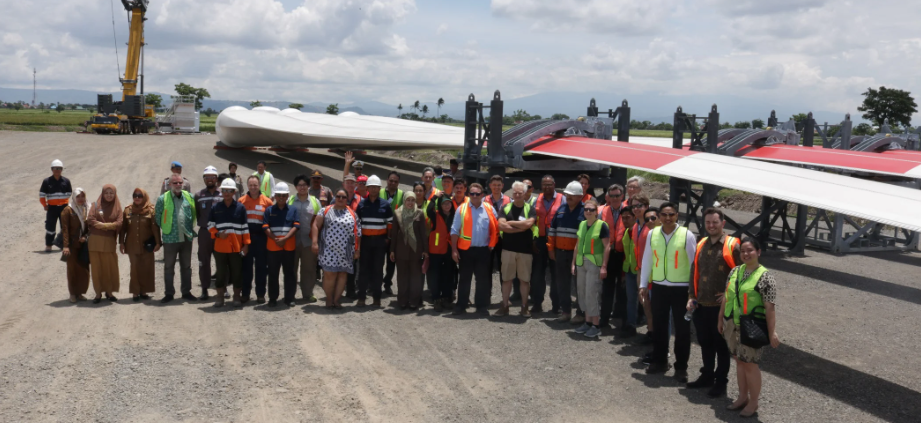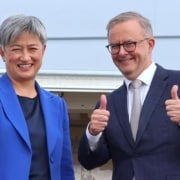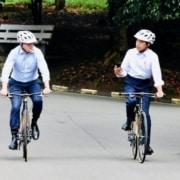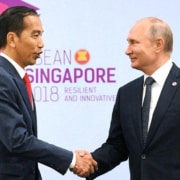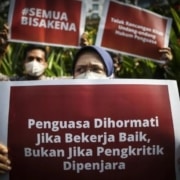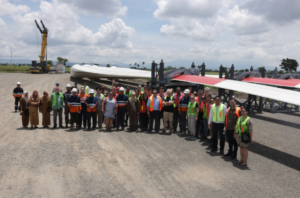
An Australian business delegation visit one of Indonesia’s first wind energy projects in Jeneponto in South Sulawesi in 2018. Photo by Rahmat Idris.
A recent report claimed the planet has entered the “beginning of the end of the fossil fuel age” with 12% of electrical energy globally generated from renewables. In our region the energy landscape is also changing rapidly, with our biggest neighbour, Indonesia, beginning its own energy transition.
Indonesia is one of the most climate-vulnerable nations in the world. According to a USAID report, over 42 million people in Indonesia live on low-lying land less than 10 meters above sea level, and over 2,000 of the archipelago’s islands will be submerged by 2050. Close to 6 million people will be displaced by annual flooding by the end of the century.
At the international level, Indonesia has committed to reduce greenhouse gas emissions by 32% by 2030, or, with international assistance, 43%. Its long-term strategy is to reach net-zero emissions by 2060 or sooner. Domestically, the president has set a target of 23% new renewable energy in its national energy mix by 2025.
This should be feasible: Indonesia, like Australia, has an abundance of solar, wind and geothermal power potential. However, it is also an important oil producer, and, like Australia, a major coal and gas producer. Powerful fossil fuel business interests have been important supporters of key political leaders. Climate change is yet to become a major domestic political issue, and renewable energy deployment in Indonesia has been slow.
But now, this is likely to change. Indonesia recently secured significant international financing commitments to support its energy transition from the Asian Development Bank’s Energy Transition Mechanism and the Just Energy Transition Partnership (JETP). The JETP, funded by the G7 plus Denmark and Norway, will mobilise US $20 billion over three to five years to help Indonesia phase down fossil-fuel energy and accelerate the transition to renewables.
Many leaders in government and the private sector also hope the nation can benefit from the economic opportunities offered by the energy transition. President Joko Widodo (Jokowi) recently launched the Kalimantan Industrial Park Indonesia (KIPI) in the province of North Kalimantan, which he said will be a centre of production for “electric-vehicle batteries, petro-chemicals and aluminium”, all powered by green electricity supplied from new hydro-power plants.
Likewise, Indonesia’s Minister for Investment and Maritime Affairs, Luhut Panjaitan, recently said that Indonesia plans to build its own EV battery industry. He added that Indonesia needs a partner for this and Australia is its best candidate. The new leadership of the state-owned monopoly electricity supplier (PLN) is increasingly open to renewables, as are senior government officials from the Ministry for Energy and Mineral Resources.
How can Australia and Indonesia work together on the energy transition?
As neighbours, it is in both our countries’ interests to work together to make the energy transition as rapid and efficient as possible. Both countries would benefit economically from a comprehensive partnership through increased investments in zero-carbon manufacturing and mining industries, energy transition education and training, and export of green products. The $A200 million climate and infrastructure partnership announced by Prime Minister Albanese in June last year (details of which are still being worked out), is a small, welcome step. But a comprehensive partnership should ideally involve all levels of government, the private sector, universities, and civil society. City-to-city and state-to-province exchanges focused on how to meet the challenges of climate change and the energy transition, would be very helpful to both sides.
Indonesia’s leadership see the potential of a partnership: in 2020 President Jokowi addressed the Australian parliament during his state visit and invited Australia to work with Indonesia on the challenge of climate change. As noted above, Minister Panjaitan has said Australia and Indonesia should work together in the manufacture of EV batteries using Australia’s abundant sources of lithium and Indonesia’s rich deposits of nickel.
Indonesian industries are also interested in securing relatively cheap green hydrogen and ammonia from Australia. Australia’s expertise and capacity in the provision of small to medium scale renewable energy projects in isolated communities could help PLN meet its goal to “de-dieselfy” island communities across eastern Indonesia (currently most island and isolated communities are powered by diesel engine generators).
Australia could also share its experience of maximising solar rooftop PV installation, development of renewable energy zones and the regulations needed for the energy transition.
Energy transition education and training
In both countries there is rapidly growing demand for newly skilled people as the energy transition gathers momentum. Australia could offer major training programs at scale in:
- electrical engineering, trades and technologies; solar and wind power installation; battery storage and grid integration; community battery and renewable energy power development; EV servicing and management; and EV charging rollout and development;
- renewable energy policy at the national, regional and community levels; energy transition and renewable energy advocacy skills; and community awareness and education programs on the energy transition; and
- emergency management training and planning for climate change events; flood mitigation and community preparedness for climate change; and city planning for climate change.
It would benefit both countries to negotiate reciprocal working visa arrangements for graduates in these fields, to meet growing employer demand.
Our regional energy landscape is changing fast. Australia and Indonesia have a golden opportunity to build a comprehensive partnership that takes us towards a vibrant, zero-carbon future.


